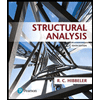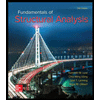Oil of viscosity μ = 0.0357 Pa's and density p = 0.796 kg/m³ is sandwiched in the small gap between two very large parallel flat plates. A third flat plate of surface area A = 20. 0 cm x 20. 0 cm (on one side) is dragged through the oil at steady velocity V = 1.00 m/s to the right as sketched. The top plate is stationary, but the bottom plate is moving at velocity V = 0.300 m/s to the left as sketched. The heights are h₁ = 1.00 mm and h2 = 1.65 mm. The force required to pull the plate through the oil is F. (a) Sketch the velocity profiles and calculate the distance ya where the velocity is zero. Hint: Since the gaps are small and the oil is very viscous, the velocity profiles are linear in both gaps. Use the no-slip conditions at the walls to determine the velocity profile in each gap. (b) Calculate force F in newtons (N) required to keep the middle plate moving at constant speed. Oil Oil H, P H, P h₁ h₂ Area = A Area = A УА V = 1.00 m/s Vw = 0.300 m/s F
Oil of viscosity μ = 0.0357 Pa's and density p = 0.796 kg/m³ is sandwiched in the small gap between two very large parallel flat plates. A third flat plate of surface area A = 20. 0 cm x 20. 0 cm (on one side) is dragged through the oil at steady velocity V = 1.00 m/s to the right as sketched. The top plate is stationary, but the bottom plate is moving at velocity V = 0.300 m/s to the left as sketched. The heights are h₁ = 1.00 mm and h2 = 1.65 mm. The force required to pull the plate through the oil is F. (a) Sketch the velocity profiles and calculate the distance ya where the velocity is zero. Hint: Since the gaps are small and the oil is very viscous, the velocity profiles are linear in both gaps. Use the no-slip conditions at the walls to determine the velocity profile in each gap. (b) Calculate force F in newtons (N) required to keep the middle plate moving at constant speed. Oil Oil H, P H, P h₁ h₂ Area = A Area = A УА V = 1.00 m/s Vw = 0.300 m/s F
Chapter2: Loads On Structures
Section: Chapter Questions
Problem 1P
Related questions
Question
100%

Transcribed Image Text:**Educational Content: Fluid Mechanics - Viscosity and Force Calculation**
**Oil Properties and Setup:**
- Viscosity (\(\mu\)): 0.0357 Pa·s
- Density (\(\rho\)): 0.796 kg/m³
A third flat plate of surface area \(A = 20.0 \, \text{cm} \times 20.0 \, \text{cm}\) is dragged through oil at a steady velocity \(V = 1.00 \, \text{m/s}\) to the right. The top plate is stationary, and the bottom plate is moving with velocity \(V = 0.300 \, \text{m/s}\) to the left.
Heights:
- \(h_1 = 1.00 \, \text{mm}\)
- \(h_2 = 1.65 \, \text{mm}\)
The force required to pull the plate through the oil is \(F\).
**Instructions:**
**(a) Velocity Profiles and Zero Velocity Distance:**
- Sketch the velocity profiles for each gap.
- Calculate the distance \(y_A\) where the velocity is zero.
- Hint: With small gaps and high viscosity, assume linear velocity profiles. Apply no-slip conditions at the walls for accuracy.
**(b) Force Calculation:**
- Calculate the force \(F\) in newtons needed to maintain the middle plate's constant speed.
**Diagram Explanation:**
- The diagram shows two horizontal gaps filled with oil, each with specified properties (\(\mu, \rho\)).
- The top boundary is static, while the bottom boundary moves left.
- The middle plate moves right, influenced by force \(F\).
- Velocity \(V = 1.00 \, \text{m/s}\) is depicted as an arrow to the right.
- Velocity \(V = 0.300 \, \text{m/s}\) is depicted as an arrow to the left.
- Distances \(h_1\) and \(h_2\) are marked between plates, with \(y_A\) indicating the zero velocity location.
Expert Solution
This question has been solved!
Explore an expertly crafted, step-by-step solution for a thorough understanding of key concepts.
This is a popular solution!
Trending now
This is a popular solution!
Step by step
Solved in 3 steps with 3 images

Knowledge Booster
Learn more about
Need a deep-dive on the concept behind this application? Look no further. Learn more about this topic, civil-engineering and related others by exploring similar questions and additional content below.Recommended textbooks for you


Structural Analysis (10th Edition)
Civil Engineering
ISBN:
9780134610672
Author:
Russell C. Hibbeler
Publisher:
PEARSON

Principles of Foundation Engineering (MindTap Cou…
Civil Engineering
ISBN:
9781337705028
Author:
Braja M. Das, Nagaratnam Sivakugan
Publisher:
Cengage Learning


Structural Analysis (10th Edition)
Civil Engineering
ISBN:
9780134610672
Author:
Russell C. Hibbeler
Publisher:
PEARSON

Principles of Foundation Engineering (MindTap Cou…
Civil Engineering
ISBN:
9781337705028
Author:
Braja M. Das, Nagaratnam Sivakugan
Publisher:
Cengage Learning

Fundamentals of Structural Analysis
Civil Engineering
ISBN:
9780073398006
Author:
Kenneth M. Leet Emeritus, Chia-Ming Uang, Joel Lanning
Publisher:
McGraw-Hill Education


Traffic and Highway Engineering
Civil Engineering
ISBN:
9781305156241
Author:
Garber, Nicholas J.
Publisher:
Cengage Learning